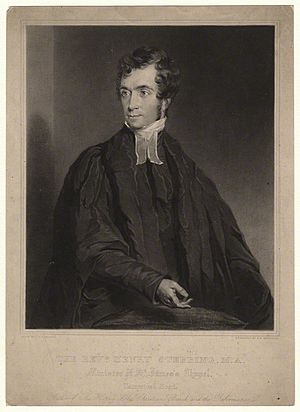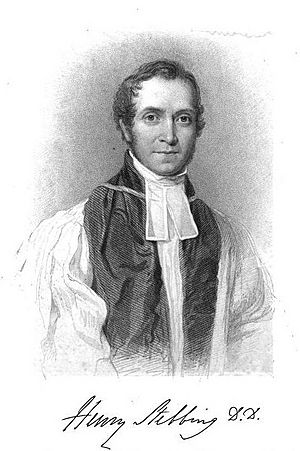Henry Stebbing (editor) facts for kids
Henry Stebbing (1799–1883) was an English clergyman and a very smart writer. He was known for his poems, his powerful speeches, and his history books. He also worked as an editor, helping to publish many books and magazines.
Contents
Henry Stebbing's Early Life and Education
Henry Stebbing was born in Great Yarmouth, England, on August 26, 1799. His father was John Stebbing and his mother was Mary Rede. In October 1818, he started studying at St. John's College, Cambridge. He earned his first degree in 1823 and continued his studies, getting more advanced degrees later. In 1857, he was also recognized by University of Oxford. He became a member of the important Royal Society in 1845.
Becoming a Clergyman
Stebbing became a deacon in the church in 1822 and a priest in 1823. Soon after, he was looking after three church areas because the main priests were away. He would ride long distances every Sunday to do his duties. In 1825, he became a lecturer at a church in Bungay, and around 1824, he became a permanent priest in Ilketshall St. Lawrence.
Moving to London and New Roles
In January 1826, Stebbing became a teacher at Norwich grammar school. One of his students there was Henry Reeve, who later became a famous journalist. In 1827, Stebbing moved to London. There, he started working for booksellers, writing and continuing his church duties.
From 1829, he was a preacher at St. James, Hampstead Road in London. From 1836 to 1857, he was the permanent priest there. He also worked at the large cemetery behind his church. From 1834 to 1879, he was a chaplain at University College hospital. For a short time in 1835, he was also the vicar of Hughenden Manor. In 1841, he was a chaplain to the Lord Mayor of London.
Later Church Work
In 1857, the bishop of London gave Stebbing the job of rector for two churches, St. Mary Somerset and St. Mary Mounthaw, in the city of London. Over the years, more churches were joined with these, making his role even bigger. He continued to lead these churches for the rest of his life.
Henry Stebbing passed away in London on September 22, 1883. He was buried in Kensal Green Cemetery.
Henry Stebbing's Writings
Stebbing's first poem, The Wanderers, was printed in 1817 and shared with his friends. In 1818, he published another collection called Minstrel of the Glen and other Poems. After he got married, he started writing more to earn money.
Working with Magazines
Stebbing was involved with the Athenæum magazine right from when it started. He helped plan it with James Silk Buckingham. His review of a book was the very first article in the magazine's first issue in 1828. He soon became the main editor for the magazine.
Stebbing was a moderate churchman, meaning he had balanced views within the church. In 1847, he wrote a letter to a politician, suggesting ways to improve the church's system of choosing priests. In 1848, he owned and edited his own magazine called Christian Enquirer and the Literary Companion.
Important Books by Henry Stebbing
Here are some of the major books Henry Stebbing wrote:
- History of Chivalry and the Crusades (1830): This book was about knights and the Crusades, which were religious wars long ago.
- Lives of the Italian Poets (1831): This was a three-volume set about famous Italian poets.
- History of the Christian Church (1833): A two-volume history of the Christian church.
- History of the Reformation (1836): Another two-volume history, this time about the Protestant Reformation.
- History of Church of Christ from Diet of Augsburg, 1530, to the Eighteenth Century (1842): This continued the history of the church from a specific time.
- The Church and its Ministers (1844).
- History of the Universal Church in Primitive Times (1845).
- The Christian in Palestine, or Scenes of Sacred History (1847): This book had illustrations based on sketches from the Holy Land.
- Short Readings on Subjects for Long Reflection (1849).
- History of Christ's Universal Church prior to the Reformation (1850).
- The long Railway Journey and other Poems (1851).
- Jesus: a poem in six Books (1851).
- Christian Graces in Olden Time: Poetical Illustrations (1852).
- Near the Cloisters (1868): This book described life in Norwich in the early 1800s.
He also wrote a continuation of a famous History of England by David Hume and Tobias Smollett. His Essay on the Study of History was published separately in 1841.
As an Editor
Henry Stebbing was a busy editor. From 1834 to 1836, he helped edit 30 volumes of Sacred Classics of England. He also edited different versions of the Diamond Bible and Diamond New Testament. He worked on Charles Knight's Pictorial Edition of the Book of Common Prayer and several other religious books.
Beyond religious texts, he edited the works of Josephus (a historian), John Bunyan (who wrote Pilgrim's Progress), and John Milton (who wrote Paradise Lost). He also edited Daniel Defoe's Journal of the Plague Year and Robinson Crusoe.
Connections with Other Writers
Stebbing knew many famous writers of his time. He had breakfast with Samuel Rogers, a poet, and met Samuel Taylor Coleridge through a friend. He talked with Walter Scott, who wrote Ivanhoe, and exchanged letters with Robert Southey, another poet. He heard Thomas Moore sing his Irish songs and knew Thomas Campbell and Charles Dickens, the famous novelist.
Henry Stebbing's Family
Henry Stebbing married Mary Griffin in 1824. She was from Norwich. Mary passed away in 1882. They had five sons and four daughters who survived them. Some of his children also became writers. His son, John, translated books from other languages. Two of his daughters, Beatrice Batty and Grace Stebbing, became known as authors.



